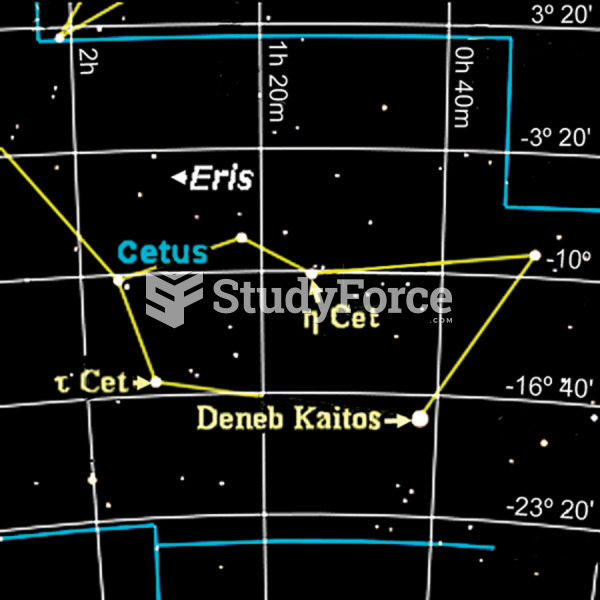A faint white dwarf that temporarily increases in brightness as a consequence of nuclear explosions on its surface is termed
a. a nova.
b. a Type II supernova.
c. a bright nebula.
d. a red giant.
Question 2
According to the Schrdinger equation, the probability of finding a hydrogen atom's ground-state electron 0.053 nm from the proton is
a. zero.
b. high, but not 100.
c. low, but not zero.
d. 100.
Question 3
The magnetic field in a superconducting solenoid is 3.0 T. How much energy per unit volume is stored in the solenoid, in J/m3? 0 = 4 107 T A/m
Question 4
The radial distance to the event horizon from the singularity of a black hole is called
a. the Roche limit.
b. the Schwarzschild radius.
c. the Hubble unit.
d. none of the above.
Question 5
Which phenomenon shows that quanta of light, or photons, exist?
a. Diffraction
b. Polarization
c. The photoelectric effect
d. Interference
Question 6
After a switch is thrown to remove the battery from a DC LR circuit, but the circuit is still left complete, the time constant represents
a. the time rate of change of the current in the circuit.
b. the time rate of change of the induced emf in the circuit.
c. the magnitude of the ratio of the current to the time rate of change of the current.
d. all of the above.
e. only (a) and (b) above.
Question 7
The end stage of the life cycle of an extremely high-mass star is a
a. quasar.
b. neutron star.
c. black hole.
d. white dwarf.
Question 8
The development of physics prior to 1900 is called
a. classical physics.
b. neoclassical physics.
c. Galilean physics.
d. ancient physics.
Question 9
When a switch is closed to complete a DC series RL circuit,
a. the electric field in the wires increases to a maximum value.
b. the magnetic field outside the wires increases to a maximum value.
c. the rate of change of the electric and magnetic fields is greatest at the instant when the switch is closed.
d. all of the above are true.
e. only (a) and (c) above are true.
Question 10
Brown dwarfs are often described as
a. quasars.
b. giant planets.
c. failed stars.
d. pulsars.
Question 11
Addition of an electron to an atom gives a
a. negative ion.
b. neutron.
c. new element.
d. positive ion.
Question 12
An inductor produces a back emf in a DC series RL circuit when a switch connecting the battery to the circuit is closed. We can explain this by
a. Lenz's law.
b. increasing magnetic flux within the coils of the inductor.
c. increasing current in the coils of the inductor.
d. all of the above.
e. only (a) and (c) above.
Question 13
Sirius is a binary star, consisting of Sirius A and Sirius B. Sirius B is a
a. red giant.
b. white dwarf.
c. planetary nebula.
d. neutron star.
Question 14
Which is another name for quantum mechanics?
a. Classical mechanics
b. Wave mechanics
c. Optical mechanics
d. Spherical mechanics
Question 15
A circuit contains two inductors of 6.0 mH inductance in series placed in parallel with an inductor of 8.0 mH inductance. After one of the 6.0 mH inductors burns out, the repair person wants to replace all three inductors with one inductor of equivalent inductance. Assuming inductors combine in series and parallel the same way resistors do, what inductance should she use?
a. 3.0 mH
b. 3.4 mH
c. 4.8 mH
d. 11 mH
e. 20 mH
Question 16
For low-mass stars, the life cycle phase that just precedes white dwarf formation is
a. planetary nebula.
b. variable star.
c. main-sequence star.
d. red giant.
Question 17
The dilemma known as the ultraviolet catastrophe was resolved in 1900 by
a. Bohr.
b. Rutherford.
c. Einstein.
d. Planck.
Question 18
A circuit contains two inductors of 6.0 mH inductance in parallel placed in series with an inductor of 8.0 mH inductance. After one of the 6.0 mH inductors burns out, the repairman wants to replace all three inductors with one inductor of equivalent inductance. Assuming inductors combine in series and parallel the same way resistors do, what inductance should he use?
a. 3.0 mH
b. 3.4 mH
c. 4.8 mH
d. 11 mH
e. 20 mH
Question 19
Stars in the process of forming are called
a. giant planets.
b. brown dwarfs.
c. red supergiants.
d. protostars.
Question 20
The planetary model of the atom is associated with
a. Bohr.
b. Thomson.
c. Dalton.
d. Rutherford.
Question 21
When a switch is closed, completing an LR series circuit, the time needed for the current to reach three-quarters its maximum value is ____ time constants.
a. 0.500
b. 0.693
c. 0.725
d. 1.33
e. 1.39
Question 22
What type of nebula is the Horsehead?
a. Primitive
b. Bright emission
c. Bright reflection
d. Dark
Question 23
The unit called the hertz (Hz) is equivalent to
a. 1/s only.
b. a reciprocal second only.
c. s-1 only.
d. all of these.
Question 24
When a switch is closed, completing an LR series circuit, the time needed for the current to reach one half its maximum value is ____ time constants.
a. 0.250
b. 0.500
c. 0.693
d. 1.00
e. 1.44
Question 25
The two major types of nebulae are
a. emission nebulae and dark nebulae.
b. bright nebulae and dark nebulae.
c. bright nebulae and reflection nebulae.
d. reflection nebulae and emission nebulae.
Question 26
Doubling the wavelength of a photon would ______________.
a. reduce its energy to one-half
b. double its energy
c. triple its energy
d. not change
Question 27
A series LC circuit contains a 100 mH inductor, a 36.0 mF capacitor and a 12 V battery. The period of the electromagnetic oscillations in the circuit is
a. 0.0227 s.
b. 0.377 s.
c. 2.26 s.
d. 105 s.
e. 1750 s.
Question 28
The next phase in the life cycle of the Sun will be
a. the formation of a red giant.
b. a move to the main sequence.
c. collapse to a white dwarf.
d. a supernova explosion.
Question 29
Doubling the wavelength of a photon would ______________ its energy.
a. halve
b. double
c. quadruple
d. not change
Question 30
A series LC circuit contains a 100 mH inductor, a 36.0 mF capacitor and a 12 V battery. The frequency of the electromagnetic oscillations in the circuit is
a. 5.73 104 Hz.
b. 9.55 103 Hz.
c. 0.442 Hz.
d. 2.65 Hz.
e. 44.0 Hz.
Question 31
The Sun has been on the main sequence
a. for about 10 million years.
b. for about 5 billion years.
c. forever.
d. for about 14 billion years.
Question 32
The smaller the frequency of light, the smaller the ______________ of its photons.
a. wavelength
b. speed
c. mass
d. energy
Question 33
A series LC circuit contains a 100 mH inductor, a 36.0 mF capacitor and a 12 V battery. The angular frequency of the electromagnetic oscillations in the circuit is
a. 36.0 104 rad/s.
b. 6.00 102 rad/s.
c. 2.78 rad/s.
d. 16.7 rad/s.
e. 277 rad/s.
Question 34
The Sun will finally become a
a. brown dwarf.
b. neutron star.
c. black hole.
d. white dwarf.
Question 35
With which object would the wave nature of matter be significant?
a. A hard-thrown baseball
b. A speeding truck
c. A moving electron
d. An orbiting planet
Question 36
What is the inductance of a series RL circuit in which R = 1.0 K if the current increases to one-third of its final value in 30 s?
a. 74 mH
b. 99 mH
c. 49 mH
d. 62 mH
e. none of the above
Question 37
What spectral class of star fits between a type G and a type M?
a. L
b. K
c. A
d. F
Question 38
Which of these instruments is based on the theory of matter waves?
a. Microwave oven
b. X-ray tube
c. Electron microscope
d. Cathode ray tube
Question 39
An ac power generator produces 50 A (rms) at 3600 V. The voltage is stepped up to 100000 V by an ideal transformer and the energy is transmitted through a long distance power line which has a resistance of 100 ohms. What percentage of the power delivered by the generator is dissipated as heat in the long-distance power line?






